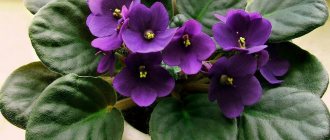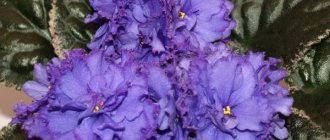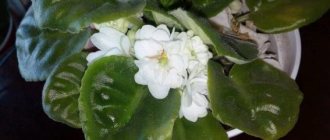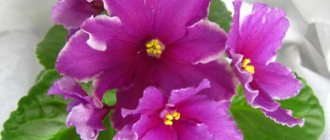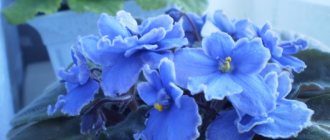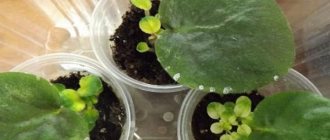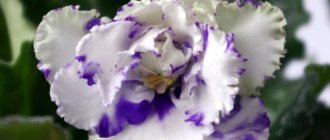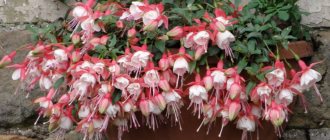After its discovery and first appearances at world flower exhibitions, the Uzambara violet especially quickly became popular among flower growers in the New World.
American lovers of indoor plants appreciated the original appearance of Saintpaulia.
They were also impressed by its ability to adapt to the proposed growing conditions in home collections, its relatively light nature and long flowering with a huge number of developing buds.
Many societies of violet connoisseurs have appeared in the country, as well as schools for breeding these exotic beauties.
Private breeders also worked to improve the decorative and varietal qualities of Saintpaulias. One of the most popular breeding group of varieties among flower growers in the world with the branded prefix “Buckeye” was created by an American master.
These violets are characterized by a magnificent exhibition appearance and do not cause any particular inconvenience when kept indoors - they are suitable for the classic care regimens for variegated varieties.
Violet Buckeye Ballerina (P. Hancock)
Author of the variety
The fancy violet "Buckeye Ballerina" was obtained as a result of scientific developments by master breeder Pat Hancock from Middletown, Ohio, USA.
IMPORTANT! The line of varieties bred by the breeder, with rare exceptions, includes Saintpaulias with variegated rosettes. Pat pays special attention to the configuration of the contours of the bush: violets with absolutely aligned rosette shapes are her trademark.
The variety first appeared at exhibitions in 1998.
Violet is quite rare in the collections of flower growers due to the frequent formation of sports.
Taxonomy
Saintpaulia "Buckeye Ballerina" in the taxonomic classification is included in the genus Saintpaulia of the Gesneriaceae family.
The size of the leaf rosette is slightly higher than the average size indicates that the variety belongs to the standard type , the fullness of the corolla refers to the terry type , and the color of the leaf blades refers to the variegated variety.
Description of appearance
The violet independently forms an exhibition leaf rosette with a symmetrical configuration of contours , an original graphic design and a mosaic arrangement of tiers. The average dimensions of the bush confirm the characteristics of the variety according to the standard type.
The leaf blades have an oval-heart-shaped shape, a quilted surface structure with glossy reflections, a finely notched edge and a faintly pronounced light venation pattern.
The leaves are painted with the color of summer greens, edged with yellowish-beige strokes and spots. Below you can see a photo of Bakai Ballerina violets.
blooms according to the bouquet type with the formation of a large number of large corollas of terry fullness, painted in shades of pinkish-lavender with abundant dark lilac fantasies throughout the entire volume of the flower.
The petals are distinguished by wavy fringed edges, set off by a thin outline of the dark lilac color, periodically interrupted and reappearing.
Sports
A significant drawback of “Buckeye Ballerina” is the frequent appearance of sports plants during propagation by leaf cuttings , which differ from varietal specimens in the absence of fancy patterns on the corollas and a change in their color:
- in purple colors of different tones;
- in pink tones;
- in purple tones.
The sport violet Buckeye Ballerina may differ from the variety solely in the color of the flowers.
Care in indoor culture
Keeping the “Buckeye Ballerina” violet in indoor collections will not cause much trouble even for novice gardeners, provided they understand all the vital processes of the plant and carefully follow the standard set of care regimens, taking into account the nuances relating to variegated varieties.
Conditions of keeping in home collections
Saintpaulia, being a representative of tropical flora, belongs to the category of light-loving plants , which should be taken into account when choosing a permanent place for it indoors. It is best if it is a windowsill - here the violet will receive the greatest illumination by the rays of the daylight spectrum.
ATTENTION! The ideal option is a window sill on the western or eastern side of the room, since with a sufficiently long period of time with daylight, the flower will be protected from burns due to contact with direct rays of light that do not fall into these windows.
The absence of windows in the correct direction in the room forces flower growers to place their beauties on less suitable window sills.
In these cases, certain conditions must be met:
- on north-facing windows, plants will require additional lighting with fluorescent spectrum lamps;
- with south-facing windows, Saintpaulia will need shading during the summer heat.
Watering and fertilizing mode
Violet requires moderate watering with constant monitoring of the drying of the top layer of the substrate before each subsequent moistening - under standard microclimate conditions, twice a week is enough.
The irrigation regime provides for the use of three possible methods of adding water to the soil:
- wick;
- directly under the root;
- into the pallet.
Flower growers independently choose the most suitable method of watering for their conditions.
A properly equipped drainage system will protect Saintpaulia from rotting of the root system when water stagnates in the lower part of the flowerpot . This issue must be resolved in advance when planting violets.
When planting violets, be sure to use drainage.
The small volume of soil in the flowerpot, combined with the frequent flowering of the plant, leads to intensive consumption of nutrients, which can be replenished by applying the necessary fertilizers.
Feeding is done approximately once a month when the need for such a procedure is visually determined.
The rules for feeding variegated violets recommend clearly checking the percentage of chemical elements in the fertilizer with the life phase of the flower:
- during growth and active formation of a rosette, more nitrogen is required;
- Phosphorus and potassium are needed during the flowering phase
CAREFULLY! Overfeeding variegated Saintpaulia with nitrogen fertilizers is fraught with a change in the intensity of the light pattern or its complete disappearance due to an increase in the rate of formation of chlorophyll, which is responsible for the green color of the leaves.
Light level control
Violet prefers to be in natural daylight for a long time , but does not like direct rays of light: it requires light from a diffuse spectrum.
With active lighting intensity, Saintpaulia may lose the brightness of the fancy coloring of the corollas and lose the variegated pattern of the leaves.
This feature should be kept in mind with additional lighting - to preserve the decorative appearance of the outlet, the pot with the plant should not be placed too close to fluorescent lamps .
Insufficient lighting also leads to negative consequences - weakening or complete disappearance of the variegated mosaic of the rosette, lengthening of peduncles or shredding of flowers.
Uniform lighting plays an important role in the growth phase of the violet for the formation of an aligned rosette - it is necessary to systematically turn the flowerpot in one direction relative to the source of light rays.
Temperature compliance
Ideal conditions for variegated violets are considered to be temperature readings within +18 +20 ° C , although in winter it is permissible to lower the mercury column by another 2 - 3 degrees - this will not cause significant inconvenience to the plant.
Growing in a cool room has a beneficial effect on the decorative appearance of the light graphics of the rosette, as well as on how long the flowering corollas retain their fresh appearance.
High indoor temperatures cause the disappearance of the variegated color of leaves, a shift in the timing of flowering or a complete refusal of it, a change in the size of leaf blades and buds, and slower development.
The temperature of keeping variegated violets should be lower than that of conventional varieties.
At any period of a violet’s life, it is necessary to protect it from sudden temperature changes and drafts .
Humidity value
Saintpaulia loves slightly more humid air than that typical for ordinary apartments and other rooms with indoor collections contained there.
Therefore, for comfortable growth of violets, you should use a variety of industrial or home-made humidifiers .
Regular spraying of the air near flowerpots with plants will also have a beneficial effect.
Soil requirements
The substrate for comfortable growth of violets should be:
- easy;
- with good nutritional properties achieved by a balanced content of chemical elements of macro and microstructure;
- permeable;
- with optimal aeration.
crushed activated carbon and fine drainage materials to it . And be sure to use drainage systems.
The need for pruning and hygiene
The vital activity of violets does not require drastic interventions by the grower by pruning the bush.
For the plant, only hygienic and preventive cleanings , including the removal of diseased or dried leaf blades, faded corollas and children.
It is possible to target young leaves when thickening the center of the rosette for optimal violet growth.
Nuances of transplantation and rejuvenation
According to the rules existing among violet growers , young, fast-growing Saintpaulia bushes are transplanted once, less than twice a year.
age-appropriate violets , replanting them only when absolutely necessary.
Young violets are replanted at least once a year.
Any transplant is accompanied by a set of preliminary measures:
- choosing a pot according to the diametrical principle, preferably made of plastic;
- preparing fresh substrate, preferably store-bought;
- formation of drainage at the bottom of the flowerpot.
The choice of transplantation method always remains with the grower, but is determined by the purpose of the operation:
- if it is necessary to examine the violet roots, transplantation with a complete replacement of the substrate is used;
- in other cases, preference is given to more gentle transshipment.
After violets have been growing in an indoor collection for about five years, it is advisable to apply a rejuvenation procedure to update the decorative appearance of the rosette while preserving the varietal characteristics. For this purpose, the upper part of the bush with young leaf plates is carefully cut off and rooted according to the classical rules of growing violets.
Violets - and that says it all!
To add at least a little beauty to this world - Violets are blooming, These are the best flowers!
Perhaps lovers of other flowers will not agree that violet is the best of them, but one thing is certain: those who once grew this magnificent plant from a simple leaf remain faithful to these flowers for a long time. They have some special aura that leaves no one indifferent who sees them.
My passion for violets has lasted quite a long time. It all started with two leaves, placed in boiled water on someone’s good advice. As a result, after planting, I received two amazing flowers: double pink and burgundy with a white border. The “descendants” of these first violets still delight me (and others) with their flowering several times a year.
On Wikipedia I found the following information about violets: Saintpaulia (lat. Saintpaulia) is a genus of beautifully flowering herbaceous plants of the Gesneriaceae family. One of the most common indoor plants; Also known in floriculture as Uzambara violet.
It grows naturally in the mountainous regions of East Africa. The plant's homeland is an area called Uzambara. For the first time such a violet appeared in the German botanical garden, and literally charmed all the inhabitants with its beauty. Therefore, it is not surprising that she soon became the favorite of all flower growers and so quickly continued her “journey” to other regions.
Violets are so diverse and amazing that we can talk about them for a very long time. And this is a very grateful and unpretentious flower; it always responds to care with abundant flowering. However, I can tell you from personal experience that he doesn't like anything too much. Everything should be moderate - both watering and sunlight. I use the most common soil for planting - the so-called basic mixture for indoor plants.
And now I hasten to share the beauty that grows and blooms in my computer class: There are
several rules, tested empirically , in order to grow beautiful flowers: place the leaf only in chilled boiled water, do not place the flower in too strong sunlight (“they burn "leaves), although just bright light does not harm the violet, do not water it too much - the roots of the flower may suffer, the water for watering should not be too cold, and be sure to “share a leaf” if someone really liked the violet. Of course, not only violets grow and bloom in my country, but that’s a completely different story...
We recommend watching:
Begonia. Care at home Why plant flowers Clivia - my orange miracle Geranium. Interesting Facts
Similar articles:
Schefflera flower. Home care
Aechmea striped. Home care
Features of flowering, growth and reproduction
The life processes of the violet “Buckeye Ballerina” proceed according to the same laws as those of other varieties of the variegated group, differing only in minor nuances.
Development in indoor culture
Violet is characterized by a non-capricious character ; it does not require the creation of any special conditions of detention, except for a relatively cool room and a slight increase in air humidity, which can be achieved using simple methods.
The formation of the rosette occurs independently ; the bush always has aligned contours and a symmetrical configuration.
The leaf plates are laid in a tiled pattern, forming an exhibition bush with a mosaic pattern.
Flowering occurs over long periods of time with the formation of a significant number of large buds . Rest breaks for this variety are short in duration.
The nuances of violet development can safely include:
- strengthening of varietal characteristics (fancy coloring of corollas) from flowering to flowering;
- disappearance of fantasy at elevated temperatures;
- slightly slower rate of growth and development;
- the formation of rosettes with very dense filling, sometimes requiring thinning;
- falling of peduncles onto a leaf rosette in low light;
- produces a large number of children when propagated by leaf cuttings;
- distinguished by his very frequent involvement in sports.
Time of formation of an adult rosette
Propagation of violets is possible from a stepson separated from the mother plant and rooted, or using leaf cuttings.
The formation of Saintpaulia, already capable of flowering, from leaf cuttings will take about 8-10 months , during which the formation of children, their rooting and the growth of leaf mass will occur.
Buckeye Ballerina is considered mature at 8-10 months.
An adult specimen from the process will be able to form a little faster.
Reproduction methods and features
Florists can use only two methods to propagate Uzambara violets:
- children formed on the violet itself;
- children formed on leaf cuttings.
The seed method for propagation in indoor culture is excluded, since it does not transmit the varietal characteristics of the specimens.
ADVICE! To ensure the preservation of all varietal characteristics of violets, it is best to use the rejuvenation method.
Flowering in different temperature conditions
At lower temperatures on the blooming corollas, the fancy coloring appears with much greater intensity, and the lifespan of each flower increases slightly due to the fact that it is kept cool for its decorative appearance.
High temperatures can not only destroy fancy patterns, but also change the shape and size of the corollas, as well as shorten the flowering period or even postpone it to another period.
Appearance of peduncles
The variety forms not too long peduncles of a fairly strong structure , capable of holding about five large corollas in an erect position, forming a lush bouquet in the center of the leaf rosette.
The strength of the peduncles is strongly influenced by the illumination of the room - with a lack of light, the peduncles increase in size, become thinner and can no longer withstand the weight of the flowers, falling onto the leaves of the rosette.
Flowering type
very neat bouquets from large buds on strong peduncles . Terry fullness and strong fringe of the corollas add volume and majesty to flower bouquets.
Bud lifespan
Violet is capable of blooming for periods of one to three months while maintaining freshness and chic decorativeness throughout the entire time. Each individual bud is able to remain decorative for approximately one to one and a half months.
Advice! Keeping the flowering specimen in a cool room can help extend this period.
My favorite Ballerina - white Uzambara violet and her sisters
There are always a lot of indoor plants in our house. They change periodically. Some die, some get bored. In their place, new wonders are purchased. My love for violets remains unchanged. These sweet homemade, so dear, indoor princesses have won my heart forever. I think that the vast majority of amateur flower growers have paid their attention to them more than once. After all, nature has created many varieties with incredibly beautiful flowers.
Description of the plant
Violets belong to the Gesneriaceae family.
The bushes have a compact, neat appearance. They grow about 20-25 cm. The flowers of these plants are simple and double, with a wavy edge. The flowers are painted in the most incredible colors from delicate shades to rich, very bright colors. Round heads of charming stamens are attached to the flower as a cute decoration: sometimes in tone with the main color of the flower, and sometimes in advantageous contrast. The leaves of violets look like small terry bursts. They are solid green, and in some species they are variegated.
Ads by
Growing conditions
They love violets
- abundance of diffused light
- air humidity 50%
- frequent transplantation
- long daylight hours
They don't like violets
- Sun rays
- it's hot
- drafts
- spraying leaves
- watering with cold water
- sudden temperature change
Planting, transplanting and propagation
I prepare the soil for violets myself: they are very demanding on the structure of the soil.
Very light, breathable, moisture-absorbing, loose soil is suitable for them. I prepare the soil mixture for violets in the following proportions:
- 2 parts garden soil
- 1 part compost humus
- 1/2 part peat
- 1/2 part vermicompost
- 1/4 part vermiculite or perlite
- 3 tbsp. spoon of wood ash per 5 liters of soil mixture
- 1 teaspoon of ZION per 5 liters of soil mixture
I try to replant violets every year, in February, using the transshipment method.
It is necessary to plant violets in such a way that the neck of the plant rises one and a half to two centimeters above the edges of the pot. Violets are propagated using the most popular methods: seeds, leaves or children. 1. Propagation by seeds Prepare a loose substrate, moisten it with a spray bottle, and sow the seeds. Place the container with the crops under the film and place in a warm, bright place. When shoots appear, the film must be removed.
2. Reproduction by leaf Cut a leaf from the plant. Powder the cut area with crushed activated carbon. Let it dry a little. Then place the violet leaf in a glass of clean water. Very soon roots will appear on the leaf. Next, we plant the leaves with roots in the prepared loose soil mixture.
3. Reproduction by children Carefully separate the child from the main bush. We moisten the soil where we will plant the baby abundantly and cover the top with an inverted glass jar or plastic container.
Watering and fertilizing
Watering violets must be approached very responsibly.
You need clean, almost spring water. If you don’t have one, then proceed as follows. Pour tap water into a container. We let it sit for a day so that the chlorine leaves the water. Then we boil the water and cool it to about +30 °C (irrigation water at room temperature is detrimental to the roots of Saintpaulia). Since violets do not like water getting on their leaves, naturally, watering should be done directly into the tray. The tray itself also needs to be washed periodically. I will add that violets need to be watered only when the top layer of soil is completely dry.
I feed violets with complex fertilizer for indoor flowers. Agricola is best suited for this purpose. The frequency of feeding is 2 times a month. It is good to add black tea or coffee grounds to the soil. In winter I don’t feed the plants, I let them rest.
Features of cultivation
For violets, pots must be chosen taking into account the fact that they have a rather small root system.
Therefore, the size of the pots should be low and moderately wide (diameter about 10 cm). The material for the pots is plastic or clay. A layer of expanded clay, pebbles, crushed coal or broken brick must be placed on the bottom of the pot. Since violets love a lot of light, but do not like the sun's rays, it is good to place flower pots on northern and western windows. Moreover, they must be constantly turned towards the light in different directions.
Sometimes, if there are errors in care, violets can get powdery mildew, leaf rust, or bacteriosis. If the first two diseases can be cured fairly quickly with antifungal drugs, then it is useless to fight the latter.
Compliance with all the rules for caring for violets (correct temperature conditions, measured watering, good lighting, balanced feeding, etc.) will help avoid stressful situations for the plant that weaken it.
Don't forget to periodically inspect your violets for insect pests such as aphids, mites, harmful worms and other parasites. Flowers treated with chemicals in a timely manner will delight you and your loved ones for a long time.
There is one more mandatory procedure that I perform weekly. This is pinching off excess shoots and removing the outermost unsightly leaves. I also remove faded, drying flowers. This procedure allows you to increase the decorativeness of the plant.
Interesting Facts
My cat is partial to violets, as probably many other cats are.
The common horror story that violets are very harmful to animals does not have the slightest basis. The flower is recognized as safe for animals. And if you feed your cats vitamins, they will not touch your violets. Violets are the cutest flowers that respond very well to proper care. Admiring and contemplating the beauty around us is what we need now in our difficult times. Another way to ease the self-isolation regime during the coronavirus epidemic.
I can say about myself that I just love them... And they pay me back in kind...
Reviews
Tatyana Grigorievna. “My collection contains about two dozen varieties of Buckeye. I recently purchased a young copy of Buckeye Ballerina. The bush itself formed a beautiful rosette, bloomed several times - I like everything about it. But there is one negative problem: with a high ability to form leaf babies, violets have an equally high percentage of the development of sports. These bushes are also good, but their varietal qualities have been lost, which means their value in terms of the distribution of the variety has been reduced.”
Gennady. “I accidentally came to a flower exhibition with my daughter. We received a lot of positive emotions and, in addition, a violet leaf “Buckeye Ballerina”. A charming violet with delicate lavender-colored buds covered with purple streaks and variegated foliage. But she attracted her daughter with her name Ballerina, since my child studies ballet. Now they are learning positions together: the daughter is at the machine, and the violet is nearby, on the windowsill.”
